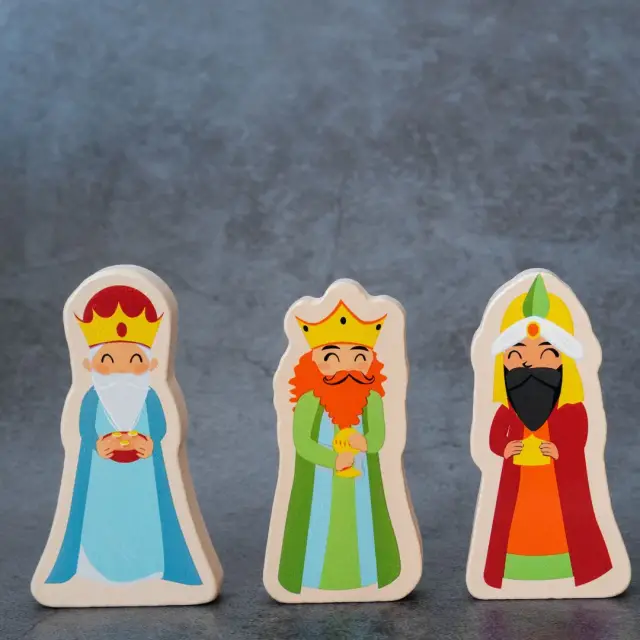Three Kings Day is one of the most significant holidays in many Spanish-speaking countries, and Colombia is no exception. Celebrated on January 6, this date marks the end of the Christmas season and commemorates the visit of the Three Wise Men to the baby Jesus in Bethlehem. Over the years, this holiday has evolved, fusing religious traditions with popular and local customs, creating a celebration rich in culture and meaning.
Origin and Meaning
The story of the Three Wise Men comes from the Gospel of Matthew in the Bible . According to tradition, three wise men from the east (Melchior, Gaspar and Baltasar) followed a star that led them to the place where Jesus was born. They brought him gifts of great symbolism: gold, frankincense and myrrh. These gifts represented Jesus' royalty, divinity, and humanity, respectively.
In Colombia, as in other Latin American countries, the arrival of the Three Wise Men symbolizes the culmination of the Christmas period and is an occasion to strengthen family and community ties. Celebrations include religious activities, such as masses and processions, as well as cultural and festive events.
Traditions and customs
Masses and Processions
In many cities and towns in Colombia, Three Kings Day begins with a special mass in the local church. Processions are also an important part of the celebration. In some regions, it is common to see parades in which people dressed as the Three Wise Men walk through the streets, often accompanied by music, dance and theatrical performances that recreate the visit of the Three Kings to the baby Jesus.
The Three Kings Parade
One of the most notable traditions is the "Cabalgata de Reyes". This is a celebration that takes place in many cities in the country, where parades are organized with horses, decorated carts and actors dressed as the Three Wise Men and other biblical characters. These parades are not only a visual spectacle, but also an opportunity for communities to gather and celebrate together.
The Rosca de Reyes
Food also plays a crucial role in celebrations. One of the most traditional elements is the Rosca de Reyes, a ring-shaped sweet bread, decorated with candied fruits and often filled with cream or chocolate. Inside the bagel a small figure of the baby Jesus is hidden, and the person who finds it in his portion is considered lucky and, in some cases, has the responsibility of organizing the Candlemas celebration on February 2.
Gift exchange
Another popular custom is the exchange of gifts, especially between children. In some regions of Colombia, children leave their shoes in the window or on the door on the night of January 5, in the hope that the Three Wise Men will leave them gifts. This tradition is similar to Santa Claus at Christmas, but maintains its own charm and cultural significance.
Regional Celebrations
Colombia, with its cultural and geographical diversity, celebrates Three Kings Day in diverse and unique ways in each region.
Andean region
In the Andean region, the celebrations are particularly vibrant. Cities like Bogotá, Medellín and Tunja organize large public events. In Tunja, for example, a cultural festival is held that includes music, dance and theater performances, all dedicated to the Three Wise Men. This festival attracts tourists and locals alike, becoming a highlight of the Christmas season.
Caribbean coast
On the Caribbean coast, celebrations are influenced by the mix of African, indigenous and European cultures. Here, festivities tend to be more colorful and joyful, with lots of dancing and music. In cities like Cartagena and Barranquilla, processions and parades are accompanied by cumbia and Mapalé rhythms, creating a festive and vibrant atmosphere.
Pacific region
The Pacific region, known for its rich Afro-Colombian heritage, celebrates Three Kings Day with a unique touch. In this area, festivities include ancestral rituals, drums and traditional songs that reflect the history and culture of the community. It is an opportunity for families and communities to come together and celebrate their traditions and cultural roots.
Eastern plains
In the Eastern Plains, celebrations are simpler but equally significant. Life in this region is deeply connected to nature and the countryside, so festivities often include outdoor activities, such as horseback riding and barbecues. Rural communities gather to share food, stories and llanera music, thus strengthening their community ties.
Cultural and Social Importance
Three Kings Day in Colombia is not only a religious celebration; It is a manifestation of the country's rich cultural diversity. The different ways of celebrating this holiday reflect the mix of indigenous, African and European traditions that have shaped Colombian identity.
Furthermore, this holiday has a deep social meaning. It is an opportunity to strengthen family and community ties, foster solidarity and share moments of joy and reflection. In a country with a history marked by conflict and social challenges, these celebrations serve as a reminder of the importance of unity and cooperation.
Like many other traditions, Three Kings Day in Colombia faces challenges in the context of modernity and globalization. The influence of foreign cultures and changes in urban lifestyles have led to some transformations in the way this holiday is celebrated.
In large cities, for example, it is common for celebrations to be more commercial, with a greater influence of advertising and consumerism. However, many communities are working to preserve the traditions and true meaning of this holiday. Cultural and religious organizations play a crucial role in keeping these customs alive, adapting them to modern times without losing their essence.
